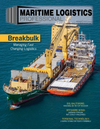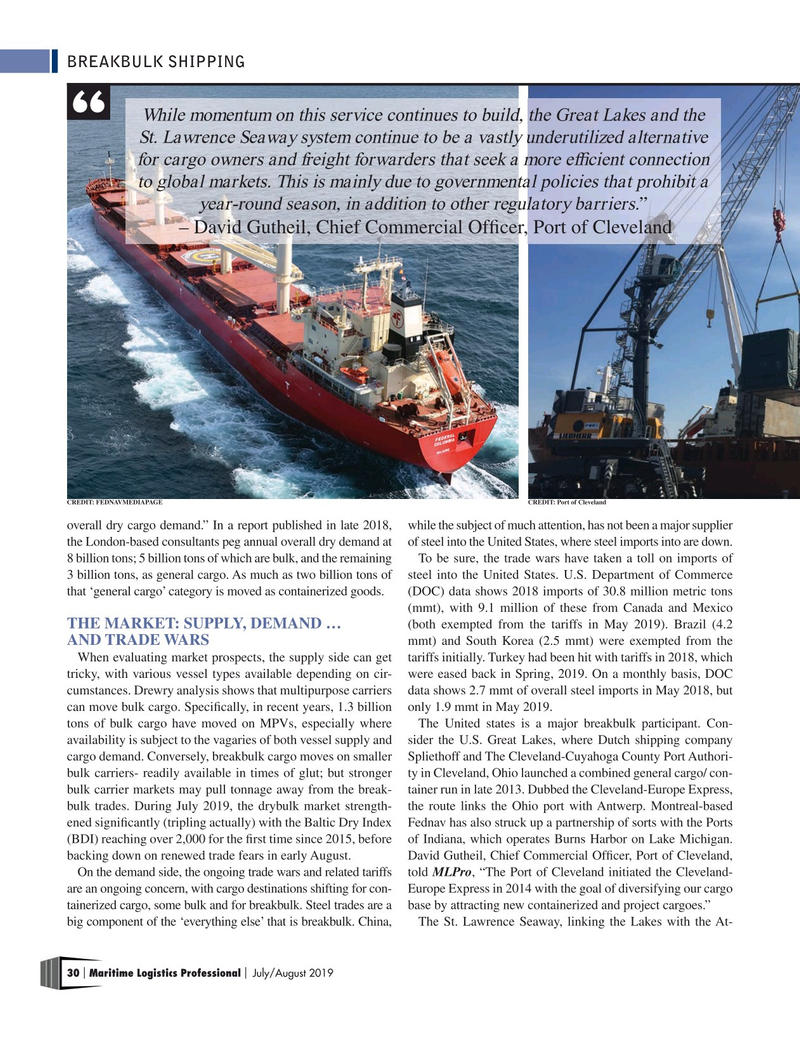
Page 30: of Maritime Logistics Professional Magazine (Jul/Aug 2019)
Breakbulk Issue
Read this page in Pdf, Flash or Html5 edition of Jul/Aug 2019 Maritime Logistics Professional Magazine
BREAKBULK SHIPPING
While momentum on this service continues to build, the Great Lakes and the
St. Lawrence Seaway system continue to be a vastly underutilized alternative for cargo owners and freight forwarders that seek a more ef? cient connection to global markets. This is mainly due to governmental policies that prohibit a year-round season, in addition to other regulatory barriers.” – David Gutheil, Chief Commercial Of? cer, Port of Cleveland
CREDIT: FEDNAVMEDIAPAGE CREDIT: Port of Cleveland overall dry cargo demand.” In a report published in late 2018, while the subject of much attention, has not been a major supplier the London-based consultants peg annual overall dry demand at of steel into the United States, where steel imports into are down. 8 billion tons; 5 billion tons of which are bulk, and the remaining To be sure, the trade wars have taken a toll on imports of 3 billion tons, as general cargo. As much as two billion tons of steel into the United States. U.S. Department of Commerce that ‘general cargo’ category is moved as containerized goods. (DOC) data shows 2018 imports of 30.8 million metric tons (mmt), with 9.1 million of these from Canada and Mexico
THE MARKET: SUPPLY, DEMAND … (both exempted from the tariffs in May 2019). Brazil (4.2 mmt) and South Korea (2.5 mmt) were exempted from the
AND TRADE WARS
When evaluating market prospects, the supply side can get tariffs initially. Turkey had been hit with tariffs in 2018, which tricky, with various vessel types available depending on cir- were eased back in Spring, 2019. On a monthly basis, DOC cumstances. Drewry analysis shows that multipurpose carriers data shows 2.7 mmt of overall steel imports in May 2018, but can move bulk cargo. Speci? cally, in recent years, 1.3 billion only 1.9 mmt in May 2019. tons of bulk cargo have moved on MPVs, especially where The United states is a major breakbulk participant. Con- availability is subject to the vagaries of both vessel supply and sider the U.S. Great Lakes, where Dutch shipping company cargo demand. Conversely, breakbulk cargo moves on smaller Spliethoff and The Cleveland-Cuyahoga County Port Authori- bulk carriers- readily available in times of glut; but stronger ty in Cleveland, Ohio launched a combined general cargo/ con- bulk carrier markets may pull tonnage away from the break- tainer run in late 2013. Dubbed the Cleveland-Europe Express, bulk trades. During July 2019, the drybulk market strength- the route links the Ohio port with Antwerp. Montreal-based ened signi? cantly (tripling actually) with the Baltic Dry Index Fednav has also struck up a partnership of sorts with the Ports (BDI) reaching over 2,000 for the ? rst time since 2015, before of Indiana, which operates Burns Harbor on Lake Michigan. backing down on renewed trade fears in early August. David Gutheil, Chief Commercial Of? cer, Port of Cleveland,
On the demand side, the ongoing trade wars and related tariffs told MLPro, “The Port of Cleveland initiated the Cleveland- are an ongoing concern, with cargo destinations shifting for con- Europe Express in 2014 with the goal of diversifying our cargo tainerized cargo, some bulk and for breakbulk. Steel trades are a base by attracting new containerized and project cargoes.” big component of the ‘everything else’ that is breakbulk. China, The St. Lawrence Seaway, linking the Lakes with the At- 30 Maritime Logistics Professional July/August 2019 | |

 29
29

 31
31
